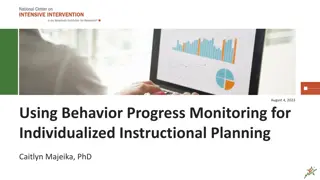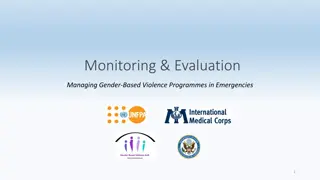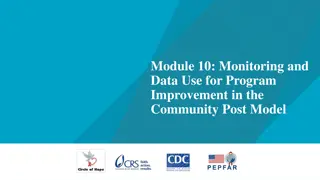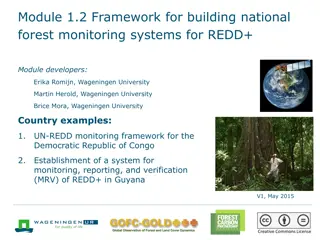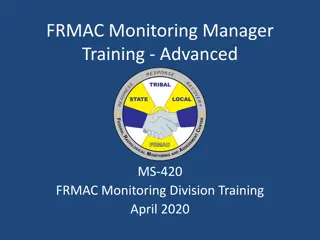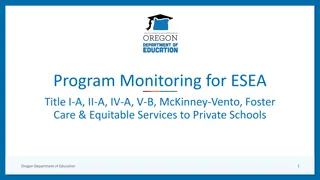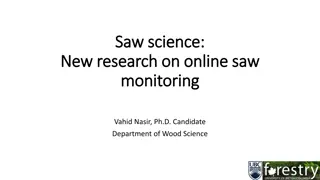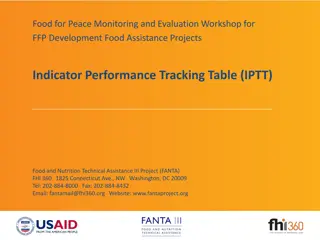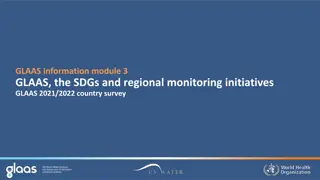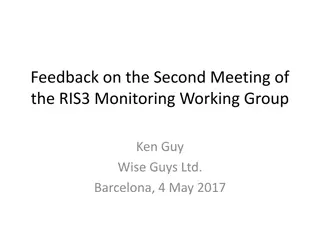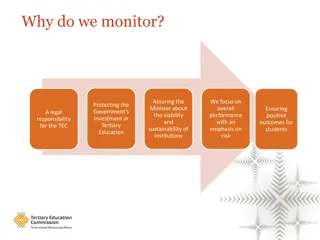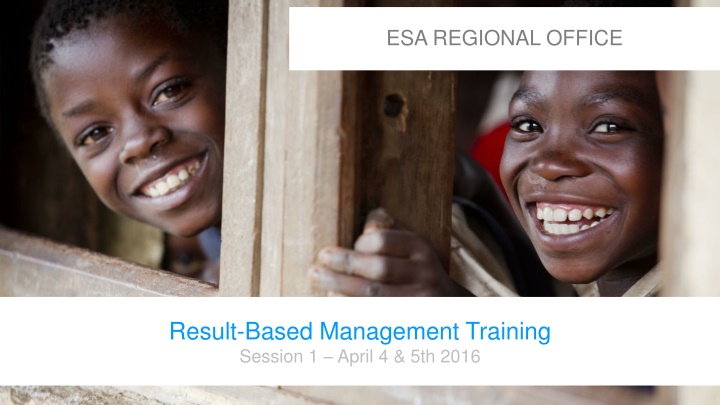
Results-Based Management Training for Effective Program Design and Monitoring
This training session focuses on applying Results-Based Management (RBM) principles to enhance program effectiveness. Participants will learn to use RBM tools, analyze problems, develop strategies, and improve monitoring and evaluation processes. Key drivers, principles, and tools of RBM will be discussed to strengthen results-oriented and equity-focused programs.
Download Presentation

Please find below an Image/Link to download the presentation.
The content on the website is provided AS IS for your information and personal use only. It may not be sold, licensed, or shared on other websites without obtaining consent from the author. If you encounter any issues during the download, it is possible that the publisher has removed the file from their server.
You are allowed to download the files provided on this website for personal or commercial use, subject to the condition that they are used lawfully. All files are the property of their respective owners.
The content on the website is provided AS IS for your information and personal use only. It may not be sold, licensed, or shared on other websites without obtaining consent from the author.
E N D
Presentation Transcript
ESA REGIONAL OFFICE Result-Based Management Training Session 1 April 4 & 5th 2016
Overall objective For participants to be able to: Apply RBM principles to the design and monitoring of programmes. Use available RBM tools and approaches to strengthen results- oriented and equity focused programmes
Agenda DAY 1 DAY 2 Key Drivers and Principles of RBM Problem Analysis Application of Lenses Results Framework Group Implementation Presentations Strategies, Risks and Assumptions Monitoring and Evaluation Outcome Chain Results Based Budgeting Prioritization Reporting
SESSION 1 KEY DRIVERS OF RBM & INTRODUCTION TO RBM PRINCIPLES
Session Objectives Understand current drivers of RBM for UNICEF Understand the RBM principles
Starting the RBM conversation Individual and small group discussions Think about RBM in your work, then Identify challenges you face in the application of RBM to your work Use VIPP cards (2 cards/per response / participant) Discuss commonalities and 3 retain cards for sharing
Results-Based Management Cycle involves RBM Conversations Context and situation analysis Learning and adjustment Quality of analysis Contributes to Strategic priorities Monitoring, Evaluation and Reporting Strategic prioritization and planning Plausibility of delivering results Implementa tion Ability to demonstrate results
Key Drivers of Results-Based Management in UNICEF The factors that drive and shape the application of RBM in UNICEF include: The equity focus Funding and Donors Reporting on results and transparency UNICEF s Strategic Plan SDGs and other global imperatives Humanitarian imperatives
State of RBM Programme Design [results] Results Level Results Quality Ratio Vertical Logic TOTAL 34% 68% 57% 61% 42% Measurability [indicators] OVERALL Indicators level Horizontal Logic Ratio Utility TOTAL 47% 60% 72% 29% Gender and Equity focus Gender focus Equity focus TOTAL RBM issues account for 34% of all CO audit recommendations 11% 7% 9%
QCPR resolution strong on RBM Requests to accelerate work to develop and sustain a results culture at all levels within the funds and programmes ..and to invest in developing capacities and competencies for results-based management; Implement a more robust, coherent and harmonized approach focused on results, which would streamline and improve the planning, monitoring, measurement and reporting on system-wide results at all levels, . Demonstrate complete results chains that establish expected results at the output, outcome and impact levels and include measurable indicators with baselines, milestones and targets for monitoring requests the United Nations development system to ensure increased mutual accountability for results-based management and reporting at the country level;
Application of RBM in UNICEF A shared understanding and commitment to results-based management approaches is an important prerequisite for success and delivery of results for women and children Programme Individual Organization Tasks Strategies Outcomes Performance Competencies Performance Country, RO. HQ Division RBM Culture Values Programme/Section Country Office Organisation Practices Processes Performance Systems Value-proposition Performance Individual
SESSION 2 PROBLEM IDENTIFICATION & CAUSAL ANALYSIS
Session Objectives Undertake causal analysis using the why s and applying the 5 lenses Identify a problem / deprivation
Problem Analysis Good understanding of context Clear problem identification and trend analysis, Sound problem analysis, and Appreciation of UNICEF comparative advantage and value proposition/addition & Will facilitate the realization and achievement of results Is the foundation for a solid Programme design
Causal analysisusing the whys Negative outcome, a right not respected, protected or fulfilled KEY DEPRIVATION WHY? BECAUSE Near and direct cause, most obvious link LENSES IMMEDIATE CAUSES BECAUSE WHY? Shortfalls in social services, lack of access, harmful beliefs, practices UNDERLYING CAUSES WHY? BECAUSE Social organization, policies, inequitable distribution of resources, governance, political issues, culture STRUCTURAL CAUSES
Problem tree High prevalence of FGMC among children less than 15 years STATE BEHAVIOUR OF CHILD / DUTY BEARER Families subject their children to FGMC FGMC Lack of awareness of health and human rights consequences of FGMC Community values FGMC and links to marriageability practitioners are known and available in the community Social and financial cost of FGMC is low SYSTEMS FGM Practice is passed from generation to generation Lack of enforcement of laws against FGMC FGMC is a social norm CONTEXT
Group Work 1. Read the assigned case study 2. Identify one deprivation / inequity / risk and trends 3. Undertake a causal analysis 4. Develop a problem tree for that deprivation using the why s methodology
SESSION 3 APPLICATION OF LENSES
Causal analysiswhys and lenses Negative outcome, a right not respected, protected or fulfilled Human rights KEY DEPRIVATION WHY? BECAUSE Equity Near and direct cause, most obvious link LENSES IMMEDIATE CAUSES Gender BECAUSE WHY? Determinants Shortfalls in social services, lack of access, harmful beliefs, practices UNDERLYING CAUSES Risk / emergencies WHY? BECAUSE Social organization, policies, inequitable distribution of resources, governance, political issues, culture STRUCTURAL CAUSES DO WE HAVE EVIDENCE?
Causal analysiswhys and lenses Is the problem identified related to a deprivation of rights of children and women? Human rights Does it highlight inequalities based on: geography, sex, income levels and population groups, etc. Equity Has a gender analysis been undertaken? Gender Have bottlenecks been analyzed against the 10 determinants? Determinants Risk / emergencies Have risks and emergencies been considered?
Group Work 1. Apply the 5 lenses to improve the problem identification and causal analysis 2. Identify strengths & weaknesses in problem analysis in the strategy note
SESSION 4 THEORY OF CHANGE: THE OUTCOME CHAIN
Session objectives Be able to move from a problem tree to an outcome chain
Theory of Change 1 If a problem is caused All three conditions By Three Conditions Must Be Addressed Interventions must not only be necessary, but also sufficient to achieve the expected result
Solution tree/Outcome chain Problem Tree Prevalence of FGMC among children less than 15 years is reduced High prevalence of FGMC among children less than 15 years Families subject their children to FGMC Families do not subject their children to FGMC Lack of awareness of health and human rights consequences of FGMC Families understand the health and human rights consequences of FGMC Community rejects FGMC and sanctions families that undertake FGM FGMC Social and financial cost of FGMC is high Social and financial cost of FGMC is low Community values FGMC and links to marriageability FGMC practitioners are known and available in the community practitioners are not available in the community FGM Practice is passed from generation to generation Lack of enforcement of laws against FGMC Laws against FGMC is enforced Practice of FGM is interrupted FGMC is no longer a social norm FGMC is a social norm
What is a Theory of Change? How will you use your programme to bring about change? The What and the How and the assumptions/risks Physical Process What will the change/success look like? What are the attributes and what are the criteria for success. CHANGE Social Process Psychological Process What is the pathway for change? Tipping point Economic Process How will you communicate it and report it? Visual plus narrative
Group work 1. Convert the problem tree to an outcome chain/solution tree Present your justification for prioritization on a flipchart paper
SESSION 5 THEORY OF CHANGE: PRIORITIZATION
Session objectives Understand how prioritization support results-focused programme design Understand UNICEF s comparative advantage Be able to prioritize actions using the funnel approach
Prioritization: Scope and focus of programmes FOCUS SCOPE OUT-OF-SCOPE Which aspects are beyond the focus and scope of the programme? Which aspects are important and within reach and capacity of UNICEF to influence but beyond the focus of the programme? Which aspects of the problem, its causes and consequences will UNICEF focus on directly and primarily Advocacy and programme monitoring Situation monitoring Everything is lack focus Interventions and investments
Prioritization Criticality of the problem + Potential to make and demonstrate results / impact = PRIORITIZATION + Comparative advantage
Comparative Advantage Analysis What is our comparative advantage? POSITIONING TO ACT BETTER THAN OTHERS MANDATE TO ACT CAPACITY TO ACT There must be capacity staff, resources, expertise and an established track record of success, but these in themselves are not sufficient. UNICEF must be seen, objectively, as being able to act better than any other development actor in the country on a specific issue.
Prioritization UNICEF cannot address all deprivations, it needs to prioritize based on its comparative advantages using 5 key filters: Criticality of national challenges / inequities SHARPENING FOCUS Mandate: Strategic Plan, alignment with global / sectoral priorities Position to act better than other partners Capacities and resources (human, financial, knowledge, technology, partners) Lessons learned, knowledge of what works and what does not Priority issues to be addressed by UNICEF
Comparative Advantage: Stakeholder Mapping Stakeholder Mapping Tool List the key stakeholders involved in this challenge /problem area What is each stakeholder already doing / likely to be doing in this area? Exercise Identify the Unique Niche of UNICEF UNICEF is the only agency that can act in this area in this way UNICEF has a unique contribution to make in this area UNICEF is better positioned than other actors
Group work 1. Undertake a stakeholder mapping against the outcome chain 2. Using the funnel approach select the deprivation / inequity that UNICEF will focus on directly and primarily in focus UNICEF will influence in scope (identify partners) Are out scope of UNICEF s programme Present your justification for prioritization on a flipchart paper
SESSION 6 THEORY OF CHANGE: STRATEGIES, RISKS AND ASSUMPTIONS
Session objectives Define programme and implementation strategies Identify key assumptions and risks Assess the risk level Mitigate risks
What will UNICEF do = Programme Strategies + Implementation Strategies Programme Strategies Identification and promotion of innovation Evidence Generation, policy dialogue and advocacy Protect Interventions Programme Partnerships Promote Prevent Care Social Norms Managing for results Service delivery Legislation / Policy Enabling Environment C4D Systems (MORES) Budget / Expenditure Interventions Management / Coordination Availability of Essential Commodities / inputs Access to Adequately Staffed Services, Facilities, and Information Supply Support to integration and cross-sectoral linkages Capacity Building Financial Access South-south and triangular cooperation Demand Social & Cultural Practices / Beliefs Timing & Continuity of Use Quality Quality
Assumptions about factors that affect outcomes FACTORS FACTORS Risks Assumptions Programme factors Within control of the programme Non programme factors Beyond control of the programme but with significant impact on results Operating environment: Demographics, industry climate, political climate, economic climate, conflict, emergency, etc. Partners contributions Programme resources Programme implementation/delivery Governance and Programme management: Managing for results Generate opportunities to be exploited and risks that should be known, monitored, managed and mitigated
Risk Assessment and Mitigation Strategies Risks are assessed along 2 dimensions Leading to overall risk level Likelihood "What is the likelihood of the risk materializing given our existing controls?" Lijellihood Minimal Critical Impact "What is the impact of the risk materializing on the grant's objectives & impact?" Mild Severe Impact High Medium Low
Group Work 1. Identify the programme interventions and implementation strategies that will support actions to bring about change and deliver results Include 1 and 2 in the outcome chain using different color VIPP cards 2. List key assumptions 3. Identify and assess, and develop mitigation strategies for 2 to 3 risks
Agenda DAY 1 DAY 2 Key Drivers and Principles of RBM Problem Analysis Application of Lenses Results Framework Group Implementation Presentations Strategies, Risks and Assumptions Monitoring and Evaluation Outcome Chain Results Based Budgeting Prioritization Reporting
SESSION 7 THE RESULTS FRAMEWORK
Session objectives Draw linkages between the results chain and the Theory of Change Understand the differences in the level of results and how to formulate results statements Understand how to incorporate a Measurement Framework

